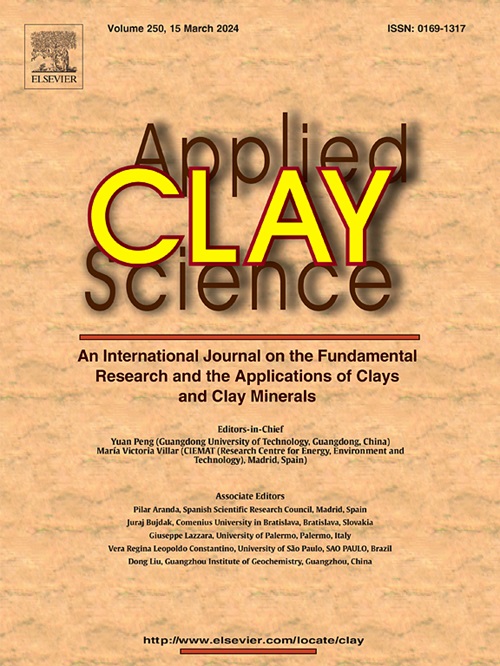利用氧化石墨烯增强偏高岭土聚合物中模拟有机核废料的稳定性
IF 5.3
2区 地球科学
Q2 CHEMISTRY, PHYSICAL
引用次数: 0
摘要
考虑到有机核废料对人类和环境的危险性质,必须以环境友好的方式处置它们。本研究通过模拟实验室中高度污染的有机废物,评估了固化/稳定方法在偏高岭土基地聚合物中有效处理有机核废料的效果。采用氧化石墨烯(GO)作为乳液稳定剂,用碱活化剂对油进行预乳化,以稳定地聚合物基质中的油滴。用阳离子表面活性剂十六烷基三甲基溴化铵(CTAB)与样品进行了性能比较。实验评价了有机废弃物在地聚合物复合材料中的乳化稳定性和固化性能。结果表明,由于氧化石墨烯在油滴周围的强大屏障,氧化石墨烯稳定乳状液具有很高的稳定性,保持恒定的成乳指数。添加氧化石墨烯、CTAB和油不影响地聚合。由于氧化石墨烯的高需水量和增加的粘度,使新鲜糊状物的流动性降低了41%。然而,它在28天后显著提高了地聚合物的抗压强度65.5%,作为纳米填料,改善了材料的负载传递和凝聚力。总有机碳(TOC)浸出试验表明,油浸出最小,低于总含油量的0.12%,在3天内稳定下来,得到高性能的有机废物固化样品。本文章由计算机程序翻译,如有差异,请以英文原文为准。

Enhanced stabilisation of simulant organic nuclear wastes in metakaolin-based geopolymers using graphene oxide
Considering the hazardous nature of organic nuclear wastes to both humans and the environment, it is essential to dispose of them in an environmentally friendly manner. This research evaluated the solidification/stabilisation method for effectively disposing of organic nuclear wastes in metakaolin-based geopolymers by simulating highly contaminated organic waste in the laboratory. The oil was pre-emulsified with an alkali activator using graphene oxide (GO) as the emulsion stabiliser to stabilise oil droplets in the geopolymer matrix. Its performance was compared with samples using the cationic surfactant hexadecyltrimethylammonium bromide (CTAB). Experiments evaluated the emulsion stability and solidification of organic waste in the geopolymer composite. The results showed that GO-stabilised emulsions were highly stable, maintaining a constant creaming index due to GO's strong barrier around the oil droplets. Adding GO, CTAB, and oil does not interfere with geopolymerisation. GO reduces the flowability of the fresh paste by 41 % due to its high water demand and increased viscosity. However, it significantly enhances the compressive strength of the geopolymer by 65.5 % after 28 days, acting as a nanofiller that improves the material's load transfer and cohesion. Total organic carbon (TOC) leaching tests show minimal oil leaching, under 0.12 % of total oil content, stabilising within three days, giving high-performance organic waste-solidified samples.
求助全文
通过发布文献求助,成功后即可免费获取论文全文。
去求助
来源期刊

Applied Clay Science
地学-矿物学
CiteScore
10.30
自引率
10.70%
发文量
289
审稿时长
39 days
期刊介绍:
Applied Clay Science aims to be an international journal attracting high quality scientific papers on clays and clay minerals, including research papers, reviews, and technical notes. The journal covers typical subjects of Fundamental and Applied Clay Science such as:
• Synthesis and purification
• Structural, crystallographic and mineralogical properties of clays and clay minerals
• Thermal properties of clays and clay minerals
• Physico-chemical properties including i) surface and interface properties; ii) thermodynamic properties; iii) mechanical properties
• Interaction with water, with polar and apolar molecules
• Colloidal properties and rheology
• Adsorption, Intercalation, Ionic exchange
• Genesis and deposits of clay minerals
• Geology and geochemistry of clays
• Modification of clays and clay minerals properties by thermal and physical treatments
• Modification by chemical treatments with organic and inorganic molecules(organoclays, pillared clays)
• Modification by biological microorganisms. etc...
 求助内容:
求助内容: 应助结果提醒方式:
应助结果提醒方式:


